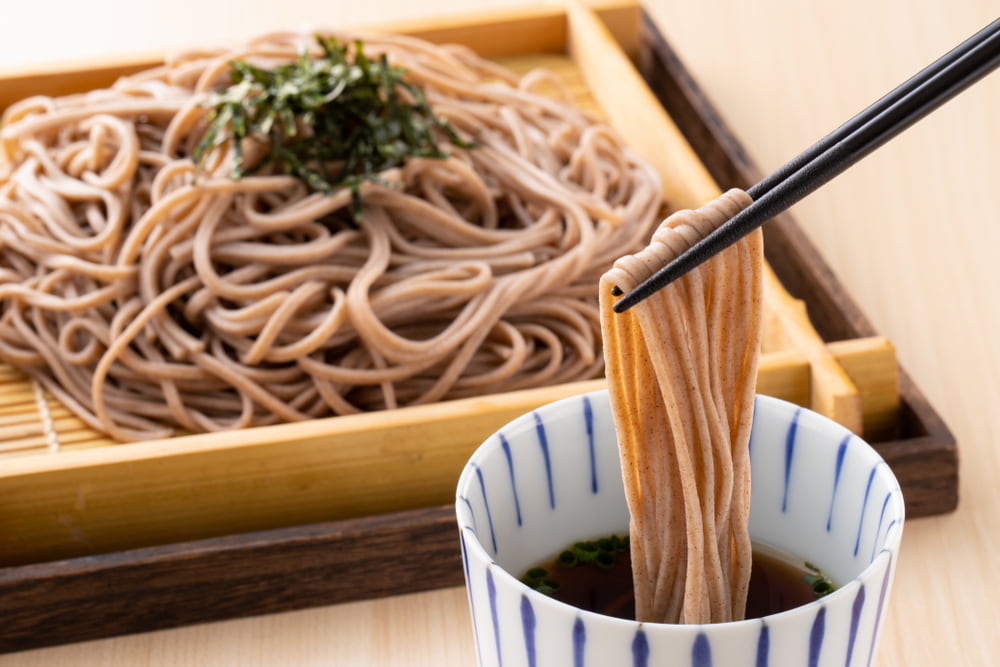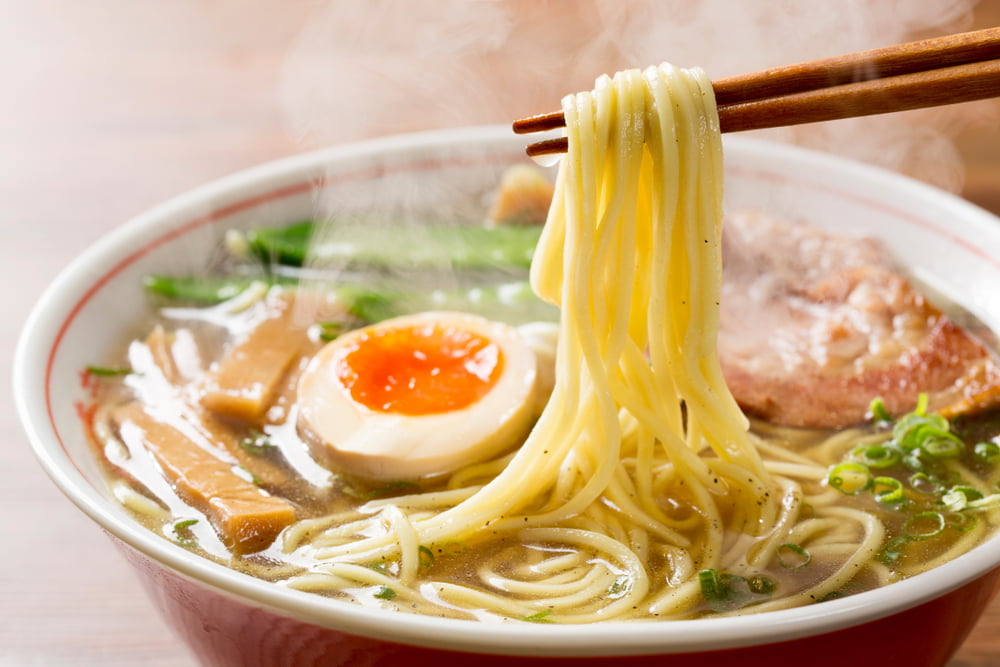
Japan is not only a popular destination for tourists but also a source of delicious cuisine that attracts food enthusiasts from around the world. The variety and uniqueness of Japanese noodle dishes, each with their own ingredients, preparation methods, and flavors, reflect the rich culture of Japan.
This article will introduce you to the 7 most popular types of Japanese noodles.
Types of Japanese Noodles
1. Soba
Soba noodles are a top choice in Japan, made from buckwheat and sometimes a small amount of wheat flour to enhance texture and tenderness. Soba is thin and light brown and can be enjoyed hot or cold in dishes such as:
- Zaru Soba: Cold soba served on a bamboo tray with a dipping sauce and garnishes like green onions, wasabi, seaweed, and boiled egg (in some places).
- Mori Soba: Similar to Zaru Soba, served cold but without a bamboo tray.
- Cha Soba: Green tea-flavored soba, available both hot and cold.
- Kake Soba: Hot soba served in a clear broth, with options to add vegetables, meat, and sometimes tempura.
2. Udon
Udon noodles, thicker than ramen and made primarily from wheat flour, originated from China and became popular in Japan during the Edo period. These noodles have a soft and chewy texture and are served in a mild broth, either hot and cold. Varieties include:
- Zaru Udon: Cold udon on a bamboo tray with dipping sauce, similar to Zaru Soba but without wasabi.
- Kitsune Udon: Udon served with sweet fried tofu, either hot or cold.
- Bukkake Udon: Thick, cold udon that can be topped with various garnishes.
- Tsukimi Udon: Served with a raw egg, available both hot and cold.
3. Ramen
Ramen noodles, also originating from China, are a highly popular type of Japanese noodle. These yellow wheat noodles have a unique texture and are known for their rich broths. The main types of ramen broth include:
- Shoyu Ramen: Soy sauce-based broth with a fragrant aroma, often served with pork, bamboo shoots, and chopped green onions.
- Shio Ramen: The oldest and simplest form, with a salty, well-balanced flavor.
- Miso Ramen: Uses miso paste as the main flavoring in the broth.
- Tonkotsu Ramen: A rich pork bone broth.
4. Somen
Somen are thin, white wheat noodles with a soft texture, enjoyed both hot and cold. Popular dishes include:
- Hiyashi Somen: Cold somen served with Tsuyu, a dipping sauce made from soy sauce, mirin, and dashi.
- Nagashi Somen: Cold somen served flowing down a long bamboo flume, eaten by catching the noodles with chopsticks.

5. Yakisoba
Yakisoba, a staple of both Japanese cuisine and street food in Thailand, involves stir-frying “chukamen” noodles, similar in appearance to ramen but coated in oil. Ingredients include cabbage, carrots, protein such as pork or seafood, flavored with a salty Yakisoba sauce or traditional Japanese sauce, often garnished with seaweed powder, pickled ginger, mayonnaise, or topped with tomato sauce for added juiciness.
6. Kuzukiri
Kuzukiri noodles are made from the starch of the kudzu plant, a pea family plant. These translucent noodles are thicker than vermicelli but softer and chewy, popular in cold dishes served with bonito or dashi soup, and often accompanied by ginger, tomatoes, and cucumber.
7. Shirataki Noodles
Shirataki noodles, similar to vermicelli but thicker, are ideal for those on a clean diet or those hoping to lose weight due to their very low calorie content—about 6 calories per 100 grams. These noodles are made without flour or sugar, offering a sweet, crunchy texture and are versatile in grilled, stir-fried, or boiled dishes, making them one of the healthiest choices among the different types of Japanese noodles.
If you’re getting hungry, we invite you to try the authentic flavors of these dishes at SATO NO UDON, one of top Japanese restaurants in Chidlom, Bangkok. Enjoy freshly served noodle dishes and explore a variety of Japanese restaurants today at The Mercury Ville near Chidlom BTS station.



